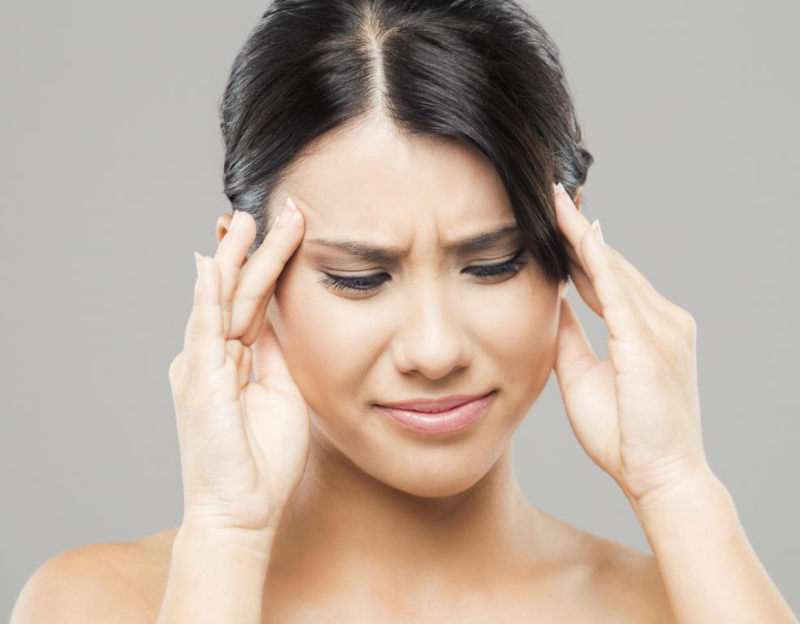
Tingling in the head is a common complaint in men and women. Generally, it does not represent a serious situation and can be alleviated with professional treatment. This sensation is usually mild and goes away after several hours.
It is often associated with a headache or a sign of stress. However, persistent tingling, which increases in intensity and is related to other symptoms, could indicate the need for medical attention as soon as possible. In this article, we tell you the possible causes of this symptom.
Contents
Features of tingling in the head
The tingling in the head can be perceived as tiny pricks, numbness, or a tingling sensation on the scalp. In addition, it can cover other areas of the face, such as the forehead, cheeks, lips, tongue, and ears.
The medical term that describes this sensation is paresthesia. Beyond the head, it is common to appear on the hands, legs, and feet. It is not usually painful, but it feels like a bubble or as if something is walking on the skin. On some occasions, it can cause burning or itching.
The most common is that it appears suddenly, lasts a short time, and disappears suddenly. However, it is also possible that it appears as a wave, starting with a slight sensation, which then becomes very intense and gradually disappears.
9 Possible Causes of Head Tingling
The causes of tingling in the head can be very varied. It is essential to be attentive to the pattern of appearance, its intensity, and the time of day in which they occur to facilitate the medical diagnosis.
1. Stress and anxiety
Anxiety and stress can manifest in different ways in the human body. According to experts, tingling in the head and other body parts and tremors and muscle tension are part of the neuromuscular physical symptoms of anxiety. These are modifications that the organism makes when faced with threatening stimuli.
Other symptoms include a feeling of tightness in the chest, dizziness, palpitations, nausea, and the perception of shortness of breath. Similarly, there are psychological changes, such as worry, feeling overwhelmed, irritability, and restlessness.

2. Cervical problems
Problems in the cervical spine can cause pain and tingling in the back of the head and neck. An example of this is cervical radiculopathies due to compression and dysfunction of the nerve roots. In these cases, the location and extent of the discomfort will depend on the affected cervical segment.
According to studies, sensory symptoms, such as paresthesias, almost always accompany the pain. They extend from the occiput and the sides of the head to the neck, shoulders, and arms.
3. Tingling in the head due to migraine
Migraine is a disease characterized by a throbbing, recurring headache that spreads to one side of the face. It can generally present with auras lasting several minutes to an hour before the acute episode.
Visual auras are the most common and include flashing lights and blurred vision. According to research, sensory symptoms may appear in some instances, such as migratory numbness of the extremities, head, face, lips, and tongue.
4. Trauma
Skull injuries can cause tingling and numbness in the head after impact. Likewise, there may be pain in the area, ear ringing, dizziness, and balance problems. Symptoms are usually transient and disappear after a couple of days.
In the case of a concussion from a blow of greater intensity, the symptoms are more severe. These include vomiting, visual disturbances, numbness in a part of the body, lightheadedness, and even loss of consciousness. Therefore, professional attention should be sought as soon as possible.
5. Lyme disease
Lyme disease is caused by the bacterium Borrelia burgdorferi, which enters the body through a tick bite. It can only transmit the pathology if it remains attached to the body for more than 24 hours.
It presents with migratory erythema and joint pain. Systemic manifestations include tingling in the head, hands, and feet. In addition, the person has palpitations, chills, fever, malaise, and a stiff neck.
6. Shingles
It is a disease characterized by vesicular lesions and pain, given by the reactivation of the varicella virus. It usually manifests itself on the trunk or face. According to studies, the person may feel tingling, shooting pain, burning, or itching before the lesions form. The latter appears 48 to 72 hours after the perception of symptoms on the skin.
7. Dental problems
Dental manipulation and dental issues, such as pulpitis, periodontitis, and dental abscess, often cause facial numbness. Studies state that the most common reason for chin numbness is dental.
Likewise, the person may feel tingling in the head and pain. This results from the shared sensory innervation of the face via the trigeminal nerve. Something similar occurs with temporomandibular joint dysfunction.
8. Sinusitis
According to studies, inflammation of the nasal mucosa and paranasal sinuses, or sinusitis, often causes pressure and tingling in the head and face. This is caused by congestion in the sinuses and irritation of some facial nerves. There is also a headache, runny nose, and tenderness of the cheeks or forehead.
9. Multiple sclerosis
It is an autoimmune disease that affects the nervous system. The clinical symptoms are very varied and include hyperreflexia, spasticity, gait disturbance, loss of sensation, and visual disturbances. In addition, studies affirm that there may be a weakness of the facial muscles and tremors in the head.

What to do before the tingling in the head?
The measures that must be taken depend on the factor that causes the tingling in the head. In people with diabetes, reducing the consumption of sugars and caffeine is convenient. Similarly, the recurrence of this symptom should be consulted with a specialist doctor.
Suppose other symptoms, such as partial or total paralysis of the face and tingling in other parts of the body, accompany the tingling in the head. In that case, it is indicated to report it to a professional as soon as possible. Also, if the sensation persists for over three days, help should be sought.